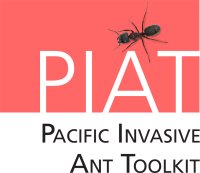Monitoring
Monitoring is undertaken for three purposes:
We have created a video that outlines the methods of monitoring for invasive ants, using yellow crazy ants as a case study. The video is also available in French. |
Monitoring methods for ants. The video is also available in French (© PIAT, Pacific Biosecurity) |
1. Evaluating treatment success
Before and after each round of treatment, ant abundance and distribution and impacts should be assessed in the same way as for delimiting and assessing impacts.
Multiple sites should be chosen in the treatment area and visual surveys (at a minimum) should be done. If time, resources and funding permit, other assessments can also be done, such as card counts (for yellow crazy ants), pitfall trapping (for ants and other insects) and luring.
2. Evaluating if treatment is required
Many factors contribute to decisions to undertake treatment of invasive ants. If the ant is one of the "worst five", it is best to consider treatment a high priority. However, if people are not being affected by the ants, there might not be much support for using pesticides.
Even if treatment is not considered a high priority, the situation should still be regularly monitored so that any worsening effects can be detected. The frequency of monitoring will depend on the time, resources and funding available. Ideally, ant monitoring should be undertaken at least every 6 months.
During each monitoring event, ant abundance, distribution and impact should be assessed in the same way as for delimiting and assessing impacts. One additional requirement is that areas outside the infestation need to be monitored in case the ant spreads.
One cost-effective way to have the monitoring done is to enlist the community to help. This also has the benefit of raising awareness, and creating support to undertake treatment.
3. Monitoring non-target effects
Monitoring for non-target effects requires planning well before treatment is undertaken. Environmental impact assessment is needed to identify any possible non-target effects.
We have provided a range of suggestions for monitoring, but what is monitored will depend on the ecological conditions at the treatment site, the species of conservation concern that are present, the budget available for monitoring, and whether people are likely to be affected. Very few studies monitor pesticide residues, which is an area of ant control that requires further study.
Content reviewed by Christina Boser, The Nature Conservancy, October 2017
